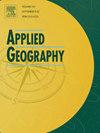Recovery of economic activities in China uncovered by remotely sensed nighttime light data under the pandemic new normal
IF 4
2区 地球科学
Q1 GEOGRAPHY
引用次数: 0
Abstract
The systematic identification of economic recovery trends and their underlying drivers under pandemic new normal offers valuable insights for shaping recovery strategies for similar crises in future. Thus, using China as a case study, we utilized nighttime light (NTL) data as a comprehensive proxy for economic activity to analyze the trajectory of economic recovery during the pandemic new normal. The differences-in-differences (DID) model was used to assess the recovery in economic volume (EV) and economic growth rate (EGR). Then, the ‘leave-one-out’ method was used to analyze individual city responses, and the random forest (RF) algorithm was employed to identify the key demographic and economic factors driving the recovery of economic activities. Results showed that despite incomplete recovery in EV (−2.7%) and EGR (−8.2%), there were notable positive time-varying spillover effects with a 47% increase in EV and a 41% increase in EGR. Meanwhile, the recovery trajectories exhibited an inverted "N" shape, reflecting a rebound pattern during the pandemic. Overall, relatively positive trends in EV recovery occurred primarily in East China, while variability in EGR responses across individual cities remained relatively insignificant. The driving mechanisms of the two economic recovery indicators were heterogeneous, with demographic factors dominating EV recovery, whereas economic factors were the primary contributors to EGR recovery.
新常态下中国经济复苏的遥感夜间灯光数据
系统地确定流行病新常态下的经济复苏趋势及其潜在驱动因素,为制定应对未来类似危机的复苏战略提供了宝贵的见解。因此,我们以中国为例,利用夜间照明(NTL)数据作为经济活动的综合代表,分析了疫情新常态期间经济复苏的轨迹。采用差异中差异(DID)模型对经济总量(EV)和经济增长率(EGR)的恢复情况进行了评估。然后,采用“留一”方法分析单个城市的响应,并采用随机森林(RF)算法识别驱动经济活动恢复的关键人口和经济因素。结果表明,尽管EV(- 2.7%)和EGR(- 8.2%)不完全恢复,但仍存在显著的正向时变溢出效应,EV增长47%,EGR增长41%。与此同时,复苏轨迹呈倒“N”形,反映了大流行期间的反弹模式。总体而言,电动汽车恢复的相对积极趋势主要发生在华东地区,而各个城市的EGR响应变化相对较小。两项经济复苏指标的驱动机制存在异质性,人口因素主导EV复苏,而经济因素是EGR复苏的主要驱动因素。
本文章由计算机程序翻译,如有差异,请以英文原文为准。
求助全文
约1分钟内获得全文
求助全文
来源期刊

Applied Geography
GEOGRAPHY-
CiteScore
8.00
自引率
2.00%
发文量
134
期刊介绍:
Applied Geography is a journal devoted to the publication of research which utilizes geographic approaches (human, physical, nature-society and GIScience) to resolve human problems that have a spatial dimension. These problems may be related to the assessment, management and allocation of the world physical and/or human resources. The underlying rationale of the journal is that only through a clear understanding of the relevant societal, physical, and coupled natural-humans systems can we resolve such problems. Papers are invited on any theme involving the application of geographical theory and methodology in the resolution of human problems.
 求助内容:
求助内容: 应助结果提醒方式:
应助结果提醒方式:


